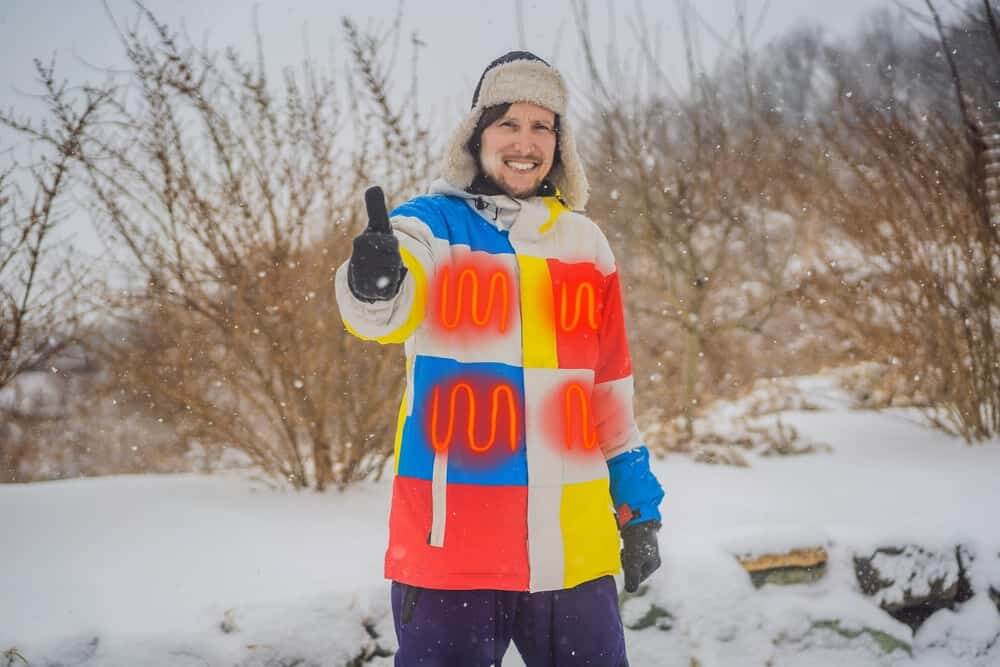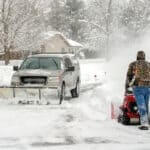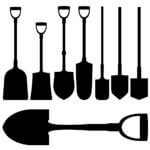The production and sale of heated wearables over the years have increased, so you can purchase everything from gloves to jackets. The development of these products has come about primarily due to motorcycle riders and an increase in electric cars that are becoming more mainstream.
This increase has morphed to include wearing heated clothing while participating in winter sports and shoveling. Unfortunately, like all new ideas, there are pros and cons to heated clothing, and being aware of what the clothing can offer will help you in making your purchasing decision.
Table of Contents
What Makes Heated Clothing Different From General Clothing?
One of the key differences between traditional clothing and heated wearables is that most require charging equipment. With clothes, this usually takes the form of an internal battery which powers heating elements located in the garment.
In contrast, many popular heated jackets tend to use removable batteries which fit into pockets outside the jacket. Although this increases bulk and weight, it means you can heat up before you have even left your front door.
Cost
The cost of heated clothing is higher. Gloves are generally the least expensive heated item to buy, retailing at around $150 Canadian/US. Socks can be purchased for $100 to $300 Canadian/US, while jackets start at $200 but can cost significantly more depending on their features and quality.
Comfort
Overall, they are comfortable to wear for several hours, but there is still some debate about whether it is safe to wear heated clothing for extended periods. In addition, there have been suggestions that overheating might be linked to conditions such as arthritis, cancer, or heart disease, although this has proven inconclusive so far. Then there is the debate on battery safety, overcharging of batteries, potential fire hazards, and energy/body absorption safety.
Are There Benefits To Wearing Heated Clothing
You bet there are benefits of wearing heated clothing. Have you ever gone outside when it’s cold and you are bundled up in many layers? So many layers that your arms no longer hang down to your side and moving around you feel like a penguin waddling?
If you answered yes to that question then heated clothing may be the thing you are looking for as you can remain warm via the heated elements without having so many layers on to keep warm.
If you participate in outdoor winter sports, you most likely prefer high-end ski wear. High-end ski wears insulating factor is generally goose down or synthetic materials designed to trap heat close to the body to prevent it from being lost through conduction.
One of the key benefits of wearing heated clothing over traditional clothing is that the heated clothing provides consistent warmth throughout the day rather than heating up only when you’re active outside. The heated clothing also does a better job of trapping air close to the body to keep you warm. Laslty, as heated wearables don’t rely on wind for insulation, they can make you warmer in colder conditions than in milder weather.
When wearing heated jackets, owners found that the coat automatically increases power when it’s very cold outside. Those who wore gloves while riding their bikes to work in very cold weather felt unusually warm even though they hadn’t been pedaling.
Most products available in the market have been designed for men. However, there are heated skirts and dresses and stylish coats for women that will help keep you warm against the elements this winter. As products develop and consumer demands rise, the stereotypes that invade new products will change.
Are Heated Clothing Items Efficient and Reliable?
Yes, the majority of modern products are surprisingly efficient, especially those powered by USB or standard lithium-ion batteries, as they charge up quickly and maintain their power levels until they’re needed later in the day.
Unfortunately, all rechargeable batteries will have some level of power loss when converted between different power sources, such as an external battery to the built-in system inside your clothes. However, this isn’t a problem for short journeys, e.g., if you only plan to go around the block or need the warmth to make it to your bus in a snowstorm. The power loss issue will arise when you use your heated clothing for a longer journey, e.g., you forgot your bus pass and needed to walk home.
The reliability of heated jackets or other heated clothing is similar to charging your phone. Most people charge up their jackets every few days just in case, which can quickly become inconvenient if you do not have access to electricity at home or work.
Most models also include an emergency power supply that will keep them working after being fully discharged but with limited duration and maximum heat output – typically around 1 or 2 hours, depending on the model.
Backup power is a beautiful thing and can be helpful, but remember that these batteries and charging systems will need to be replaced after several years of use, affecting the overall cost of owning a heated jacket.
Are Heated Clothing Items Safe?
Yes, heated jackets and other wearables are safe if you are mindful of what they are and what they can do, and the potential pitfalls. You wouldn’t wear a swimsuit out to shovel snow as you are aware that there are many dangers to you in doing so. Think ahead and ensure you have a backup plan if your heated clothing runs out of power and you have many miles to go; you don’t want to freeze; this can be extremely dangerous. Do not rely too heavily on heated wearables when traveling long distances, especially when outside of urban areas where support may be difficult to reach quickly.
Another safety concern is that while these products often work well in colder conditions, batteries drain faster than usual at higher altitudes or low temperatures. Even if they are advertised as water-resistant, they are not designed to handle rain downpours or snow, so keeping them covered up is essential even in good weather.
For safety reasons, heated clothing is not recommended for individuals who fall into any of these categories: an individual who is unable to feel their skin temperature, control their muscles, have a pacemaker, pregnant women, children under ten years of age. Heated clothing can interfere with electronic devices that contain sensitive microchips, such as pacemakers, smartwatches, or even electric road bikes, so it’s important to check whether this type of gear is suitable for you before buying it.
The heating elements inside these products may also become hot to the touch while in use, leading to injuries if your skin comes into contact with them. So make sure to test them properly before wearing them in any situation where this might occur unexpectedly.
What Are The Cons Of Heated Clothing
Heated jackets and other wearables are not cheao, if you choose a good quality product with all the features you want, it will often cost more than most clothing choices.
Know what heated clothing can and can’t do
These products are only valuable for low temperatures, so don’t expect them to cope well during summer or at high elevations where colder weather gear is usually needed instead.
In addition, some heated clothing owners complain that their heated jackets do not charge up as quickly as they like, increasing the overall time to charge, usage, and ownership cost.
Heated jackets are not easily adjustable.
Most heated clothing heats up to a certain degree, then turns off entirely until you move again because the heating elements are fitted in seams or pockets within the clothing.
As the element is pre-assigned a location in the clothing, you cannot adjust their location. Some users have overcome this issue by wearing several layers at once to cover all the angles. This is brilliant thinking, but it can often lead to overheating your body, so be careful.
Varying levels of warmth
Most heated clothing heats up to a certain degree, then turns off entirely until you move again because the heating elements are fitted in seams or pockets within the clothing.
As the element is pre-assigned a location in the clothing, you cannot adjust their location.
Some users have overcome this issue by wearing several layers at once to cover all the angles.
This is brilliant thinking, but it can often lead to overheating your body, so be careful.
Dead batteries
f your battery dies, you’re stuck in the cold as it will no longer provide any heat at all – which could turn an unpleasant journey into a dangerous situation.
Plan and ensure you pack your charger or enough spare batteries, so everything is ready to go if needed.
Weight
Heated gear is often bulky and heavy due to the batteries. Though the weight and bulkiness may be less for you depending on your situation.
As a result, the clothing may feel too large and can feel very heavy on your shoulders when worn for a long time, which could make them uncomfortable if you’re planning to wear them during activities such as cycling or running.
While some sets may provide good value for money, look closely at what each product has to offer and how well it will perform for your needs before committing yourself financially.
It could end up saving you a lot of hassle over time if you choose the right product from the beginning.
Some jackets come with small cables which attach to the built-in batteries.
Unfortunately, these wires are usually quite long and often remain visible even when the jacket is worn, so they can get in the way when people are sitting down, walking, or reaching for something quickly.
What Are The Pros Of Heated Clothing
Warmth
If you live in a climate where it is cold then having a heated jacket or other wearable will keep you warm.
Duration of time spent outside
When we are out shoveling, walking or getting to and from work, or waiting for a bus our ability to stay outside is dependent on how warm we are.
Heated clothing helps us to stay warm so our ability to stay outside is definitely increased.
Keeping warm is good for our muscles
When we are warm our muscles are more efficient. We will have an increased range of motion to complete the task we are doing. Also, our recovery time in doing the task will be lessened.
Decreased injuries
If we are warm then the blood flow to our extremities is maintained which means our movement is not strained and any potential injury would be less.
You can warm almost any part of your body
Cold feet- no problem there are heated socks to help you keep warm.
Cold hands- no problem there are heated gloves.
Cold torso- no problem there are heated jackets.
Cold head- no problem there are heated hats to keep your head warm.
Enjoyment
With heated clothing on board, you can enjoy the time you do spend outside when it is cold.
Whether you are doing work, shoveling, or are outside for recreational purposes such as fishing, biking, riding a motorcycle, or walking heated clothing has you covered, literally.
Final Thoughts
Though we have discussed the worst and best possible scenarios of heated clothing, heated wearables will rarely let you down when it comes to reliability.
Modern lithium-ion batteries can be left on standby for several days of regular use before they need recharging, which means you don’t have to worry about running out of power during the day if your jacket is set to ‘auto’ or by schedule. Moreover, these products usually are somewhat effective for both short and long journeys when it comes to safety.
The truth is that the value of having heated clothing is a personal choice depending on what you want. We are all unique, and in the end, it all comes down to how comfortable and warm this product will make you feel, especially if you usually find winter conditions very challenging.
Frequently Asked Questions
Why do my hands and fingers get so cold even with gloves on?
Can you get heated gloves wet?
However, many electrically powered products won’t last very long before they need replacing without proper maintenance and care.






